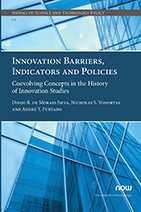Innovation Barriers, Indicators and Policies: Coevolving Concepts in the History of Innovation Studies
By Diego R. de Moraes Silva, Sivis Institute, Curitiba-PR, Brazil, moraessilva.diego@gmail.com | Nicholas S. Vonortas, Institute for International Science and Technology Policy and Department of Economics, The George Washington University, USA, São Paulo Excellence Chair, University of Campinas, Campinas-SP, Brazil, and Institute for Statistical Studies and Economics of Knowledge, National Research University Higher School of Economics, Moscow, Russia, vonortas@gwu.edu | André T. Furtado, Department of Science and Technology Policy, University of Campinas, Campinas-SP, Brazil, afurtado@unicamp.br
Abstract
This monograph discusses the coevolution of innovation barriers, indicators, and policies throughout the history of Innovation Studies. Our study starts with a thorough review of the theoretical and historical literature addressing the origins of these concepts to demonstrate that innovation barriers are intimately related to both the theoretical development of the innovation concept and its measurement as well as the policy-driven interest on innovation debates. The absence of a dominant epistemological paradigm in the field of Innovation Studies is arguably an important explanatory factor for the underuse of innovation indicators in policy decision-making which is in antithesis to the significant developments in the innovation measurement enterprise during the past few decades. We conclude that, although the context of changing paradigms benefits the creative freedom for research, it also hampers the stability and standardization necessary for the absorption of innovation indicators into the policy cycle. Efforts to change such a situation continue to this date.
Innovation Barriers, Indicators and Policies: Coevolving Concepts in the History of Innovation Studies
Innovation Barriers, Indicators and Policies explores the historical coevolution of these three core concepts in the field: barriers, indicators, and policies. The authors show how these concepts have coevolved and reinforced each other throughout the history of Innovation Studies. This detailed historical review on the general conception of innovation is warranted in order to support a clear understanding of innovation barriers, indicators, and related policies as they have been shaped and co-evolved through time. Based on the thorough review of innovation barriers undertaken herein, we see that financial and non-financial obstacles do not affect the innovation output directly. Instead they impede the effect of the innovation determinants, whether these determinants are firm-specific, network-specific, or referring to the contextual environment. Section 2 presents a thorough discussion on the historical evolution of the innovation concept and its connection to the concepts of barriers, indicators, and policies. Section 3 discusses the beginnings of the measurement of innovation barriers, as well as the linkage between the study of obstacles to innovation and a policy-driven approach towards scientific and technological progress. Finally, Section 4 concludes with the main findings and avenues for future study.
